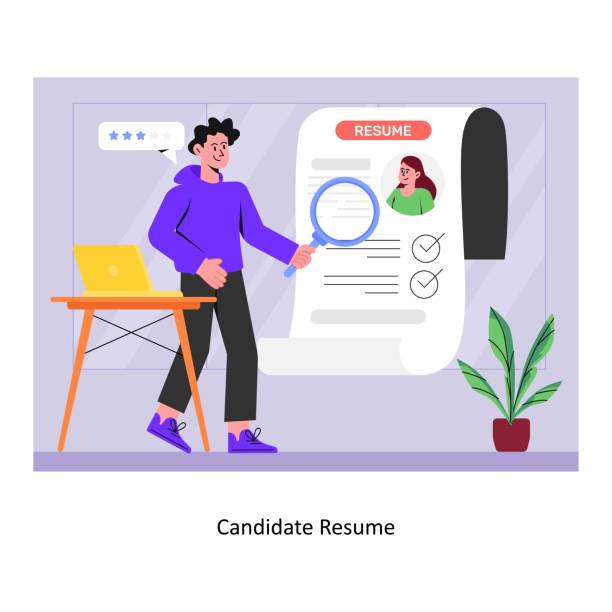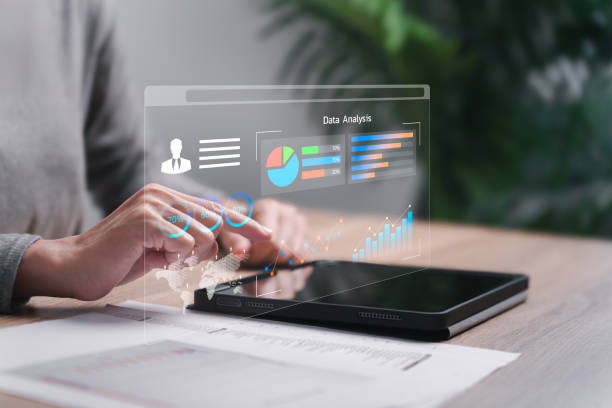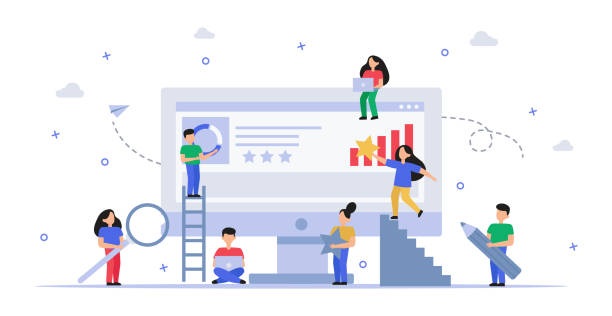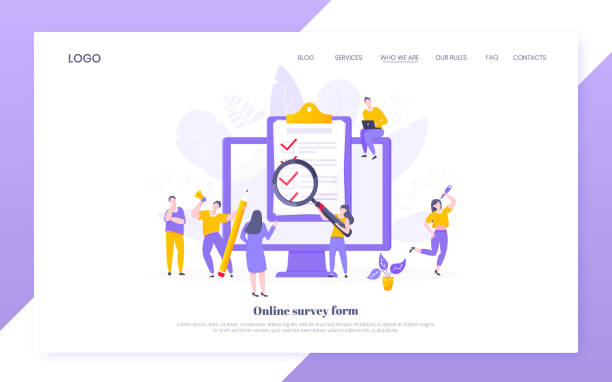Understanding Modern UI Website Design: The Backbone of User Experience

In the fast-paced world of #web and #internet, the first thing that attracts and retains visitors is not just the site’s content, but their #user_experience.
Modern UI website design is no longer a competitive advantage; it’s an indispensable necessity.
This approach focuses on creating websites that not only look beautiful but are also easy, enjoyable, and completely intuitive to use.
The ultimate goal is to reduce friction for the user and guide them towards the site’s business or informational objectives.
From the moment a user arrives, modern design elements should place them on a smooth, uninterrupted path to find what they need without confusion.
This explanatory process involves a deep understanding of user behavior and applying psychological principles to shape digital interactions.
A modern user interface goes beyond aesthetics; it’s about #functionality, #ease_of_use, and #accessibility.
Websites designed with this approach typically feature responsive design to display correctly on any device, from desktops to mobile phones.
Furthermore, the use of white space, readable typography, smart color palettes, and clear navigation are prominent features of this type of design.
These elements together help users effortlessly and quickly access the information they need.
The importance of this is that a poor user interface can quickly drive users away from a website and increase the bounce rate, while good design can encourage users to stay longer and interact more deeply with the content.
In fact, modern UI website design is a foundation for the success of any online business.
This design not only helps improve interactions but also greatly contributes to a business’s branding and credibility.
Today’s users have high expectations for websites; they seek fast, personalized, and pleasant experiences.
Ignoring these expectations can mean losing customers and business opportunities.
Therefore, investing in designing a website with a strong and modern user interface is a strategic step to ensure an effective and sustainable presence in the digital space.
This concept includes all stages from initial design and wireframing to final implementation and testing to ensure that every component of the website best meets user needs.
More information about User Interface.
Do you know that a weak corporate website takes away many opportunities from you daily? Solve this problem forever with professional corporate website design by Rasavveb!
✅ Create a powerful and reliable image for your brand
✅ Attract targeted new customers and increase sales
⚡ [Get free website design consultation]
Fundamental Principles of User-Centered Design for Websites

For #user_friendly_website_design, understanding and applying the principles of #User_Centered_Design are essential.
These educational principles form the core of the modern UI website design process.
The first step is a deep understanding of users; who they are, what their needs are, and what problems they are trying to solve? This understanding is gained through user research, such as interviews, surveys, and creating user personas.
After understanding the users, the focus must be on Usability.
A website should be designed so that users can complete their tasks quickly and effortlessly.
The next principle is #Accessibility.
This means that the website must be accessible to everyone, including people with disabilities.
Using alt text for images, appropriate color contrast, and keyboard navigation are just a few examples of accessibility considerations.
Furthermore, #Responsiveness is of high importance.
The website must display well across various devices and screen sizes, from smartphones to large monitors, and provide a consistent user experience.
This is particularly vital given the increasing use of mobile phones for internet access.
Also, continuous feedback and iteration are important in the user-centered design process.
This means that design is not a static process, but a dynamic cycle that includes designing, testing, gathering feedback, and continuous improvement.
Usability testing with real users can reveal the strengths and weaknesses of a design and help the design team implement necessary improvements.
Ultimately, Simplicity and Clarity should be prioritized.
The user interface should not be cluttered or confusing.
Information should be conveyed clearly and with minimal words so that users quickly grasp the message.
These fundamental principles not only help improve the user experience but also play a significant role in the overall success of the website and help structure websites with the goal of serving users better.
The Role of UX/UI Research in Modern UI Website Design

UX/UI research plays a vital role in the #specialized #modern_UI_website_design process.
Before even a single line of code is written or a visual element is designed, a deep understanding of users, their needs, and the product’s context of use is essential.
This research includes various methods such as in-depth interviews, surveys, focus groups, and competitor analysis.
The goal of this research is to collect quantitative and qualitative data that helps designers make informed decisions throughout the design process.
Creating Personas, or hypothetical but data-driven representations of target users, is one of the main outputs of this phase.
These personas help the design team look at user needs and pain points with greater empathy.
After the research phase, it’s time for Wireframing and Prototyping.
Wireframes are initial, simple layouts of web page structure and content that focus on arrangement and information hierarchy, rather than aesthetics.
This step allows for quick testing and optimization of user flow and website navigation.
After wireframes are approved, prototypes or interactive mockups are created.
These prototypes are simulations of the final website that can be used for usability testing with real users.
This iterative process helps discover and fix design issues in early stages, before incurring high costs for final development.
These steps ensure that the final product not only meets user needs but also provides an efficient and enjoyable experience.
Finally, UX/UI research is an ongoing process.
Even after a website launch, feedback collection continues through data analysis (like Google Analytics), heatmaps, and in-site surveys.
This information helps in the continuous improvement of the website and its adaptation to changing user needs and market trends.
An experienced UX/UI team can ensure that modern UI website design is based on real data and insights, not merely guesswork.
This precision in the initial phase saves time and cost in the long run and leads to the delivery of a high-quality, user-friendly product.
Main Stages of UX/UI Research
| Stage | Description | Tools & Methods |
|---|---|---|
| 1. Research & Discovery |
Deep understanding of users, their needs, goals, and challenges. | Interviews, Surveys, Competitor analysis, Persona creation |
| 2. Analysis & Conceptualization |
Organizing information and ideating solutions. | User journey maps, User flows, Information architecture |
| 3. Design & Prototyping |
Creating visual and interactive website designs. | Wireframing, Prototyping, UI Design |
| 4. Testing & Evaluation |
Testing designs with real users and gathering feedback. | Usability testing, A/B testing, Data analysis |
| 5. Implementation & Maintenance |
Converting design into a live website and continuous updates. | Web development, Performance monitoring, Content updates |
Visual Aesthetics and Its Importance in Branding

Visual aesthetics in #advanced_UI_web_design goes beyond simply “being beautiful”; it’s a deep #analysis of how visual elements impact user perception and brand identity.
The correct choice of colors, fonts, images, and icons can convey a powerful message about the brand and evoke specific emotions in the user.
For example, blue is typically associated with trust and stability, while red can evoke passion and excitement.
These conscious choices in the website’s color palette must align with the overall brand identity to create a unified and memorable visual experience.
#Typography, or the art of choosing and arranging fonts, plays a crucial role in readability and visual appeal.
Correct fonts can set the tone of a website and give it personality.
Using too many or inappropriate fonts can lead to visual clutter and reduced readability.
A successful design chooses a limited number of fonts that both align with the brand and are easily readable across various sizes and devices.
Images and videos, if high-quality and relevant, can also quickly convey messages and increase user engagement.
About the importance of visual design.
Furthermore, white space or negative space, often overlooked, holds great importance in visual design.
This space allows the user’s eye to rest and maintain focus on important elements of the page.
Appropriate white space gives the website a clean and modern look and prevents clutter and confusion.
Harmony and consistency across all visual elements, from the logo to buttons and forms, strengthen the brand and give users a sense of professionalism and trustworthiness.
A visually cohesive and appealing website not only attracts users but also encourages them to stay longer and explore the content more deeply, significantly enhancing the overall user experience.
Tired of your company’s website not being seen as it should be, and losing potential customers? Solve this problem forever with professional and effective website design by Rasavveb!
✅ Increase brand credibility and gain customer trust
✅ Attract targeted sales leads
⚡ Contact us now for a free website design consultation!
Interactive Elements and Microinteractions: A Big Difference in User Experience
![]()
In modern user experience website design, the focus is on small details that can be #entertaining yet highly effective: #microinteractions.
These are small visual or auditory animations or feedbacks that occur in response to user actions, such as clicking a button, filling out a form, or loading a page.
At first glance, they might seem insignificant, but they play a crucial role in enhancing the user experience and creating a sense of liveliness on the website.
For example, an animation that appears when adding a product to the shopping cart, or a visual feedback when a form is confirmed, can inform the user that their operation was successful.
Microinteractions not only serve an informative purpose but can also be #entertaining and delightful.
A creative and subtle animation can surprise and please the user, adding a sense of humanity and attention to detail to the website.
These small elements transform a dry information repository into an interactive and engaging experience.
They help users better understand the system’s status and prevent confusion.
For instance, an attractive and animated loading spinner can make the waiting time less tedious for the user and distract their attention.
Moreover, microinteractions can also help with #user_guidance.
For example, when a user clicks on an option and it changes color or slightly expands, it provides visual feedback that their selection has been registered.
These feedbacks give the user confidence and encourage them to interact more with the website.
Designing these small elements requires precision and attention to detail.
They must be fast, smooth, and brand-consistent to provide a positive and flawless experience.
Ignoring microinteractions means missing a great opportunity to elevate the quality of website design and create a lasting user experience.
Microinteractions and their principles.
Responsive Design and Mobile-First Approach: A Guide for the Future of the Web

In today’s era, where smartphones and tablets have become the primary tools for internet access, #responsive_design and the #Mobile_First approach are not just a #guide but a golden standard in modern user-centric website design.
Responsive design means that your website automatically adjusts its layout and content to the user’s device screen size.
This ensures that the website displays correctly and with the best quality on any device, from a large desktop computer to a small smartphone.
This approach means saying goodbye to the need for developing separate versions for mobile and desktop.
The mobile-first approach takes it a step further.
In this method, designers first start designing the website for the smallest screens (mobile) and then gradually expand it for larger screens (tablet and desktop).
This approach is vital for several reasons: Firstly, mobile development requires focusing on essential content and key functionality, as screen space is limited.
This helps eliminate superfluous elements and creates a simpler, more efficient user experience.
Secondly, search engines like Google give higher rankings to mobile-friendly websites, which means improved SEO and website ranking in search results.
Implementing an effective responsive design requires using #flexible_CSS_codes (Flexbox, Grid), mobile-optimized images, and simple, accessible navigation.
Designers must pay special attention to how mobile users interact (such as using touch instead of click).
This includes using larger buttons, dropdown menus (Hamburger Menus), and minimizing the need for typing.
Given that over half of web traffic comes from mobile devices, neglecting this aspect of design can mean losing a significant portion of the audience.
Therefore, for anyone seeking a successful and future-proof website, investing in responsive design and adopting a mobile-first approach is a smart and essential step.
Optimizing Site Performance for Modern User Experience: Important News for Visitors

Website speed is a critical factor in #modern_UI_website_design and is #news that can directly impact your website’s user experience and success.
Today’s users expect web pages to load in a fraction of a second, and any delay, however brief, can lead to site abandonment and an increased bounce rate.
Google and other search engines also consider page load speed as an important ranking factor.
Therefore, optimizing website performance is not only essential for user satisfaction but also important for improving SEO and online visibility.
There are various methods for optimizing website performance.
Compressing images and media files is one of the most effective ways.
Large images can significantly reduce page load speed.
Using next-generation image formats (like WebP) and optimizing them without compromising quality is crucial.
Additionally, minifying CSS, JavaScript, and HTML files by removing extra characters like white spaces and comments can reduce file sizes and improve loading speed.
Using Content Delivery Networks (CDNs) can also help accelerate content delivery to users worldwide, as content is served from the server closest to the user.
Improving server response time, content caching, and eliminating render-blocking scripts are other advanced techniques for optimizing website performance.
A fast website not only keeps users satisfied but also allows them to easily navigate the site and access the information they need.
This improved user experience leads to an increased Conversion Rate, reduced bounce rate, and ultimately, greater success for your online business.
Therefore, continuous monitoring of website performance and applying necessary optimizations are integral parts of modern website management.
Learn how to improve site speed.
Key Website Performance Metrics (Core Web Vitals)
| Metric | Description | Good Standard (for 90% of users) |
|---|---|---|
| Largest Contentful Paint (LCP) | The time it takes for the largest content element visible in the viewport to load. | Under 2.5 seconds |
| First Input Delay (FID) | The delay from when a user first interacts (e.g., clicks a button) until the browser responds. | Under 100 milliseconds |
| Cumulative Layout Shift (CLS) | The extent of unexpected layout shifts on the page. | Under 0.1 |
| Time to Interactive (TTI) | The time until the page is fully interactive and responds to user input. | Under 5 seconds |
Accessibility in Leading UI Website Design: A Question for Everyone

Is your website usable by everyone? This #thought_provoking_content lies at the heart of the concept of #Accessibility in leading UI website design.
Accessibility means designing websites that people with disabilities (such as visual, auditory, motor, or cognitive impairments) can also easily use.
Ignoring this aspect is not only ethically wrong but can also mean losing a significant portion of the audience and even entail legal consequences.
Accessible websites provide a better user experience not only for people with disabilities but for all users.
Implementing accessibility involves adhering to a set of guidelines and best practices.
Using Alt Text for images is one of the basic principles that helps screen readers describe image content for visually impaired individuals.
Ensuring proper color contrast between text and background is vital for users with low vision or color blindness.
Also, keyboard navigation is essential for users who cannot use a mouse.
This means ensuring that all interactive elements of the site are accessible and activatable with navigation keys (like Tab).
The World Wide Web Consortium (W3C) has provided Web Content Accessibility Guidelines (WCAG) to help designers and developers make their websites more accessible.
These guidelines state four fundamental principles: Perceivable, Operable, Understandable, and Robust.
By following these principles, one can build a website that is not only beautiful and modern but also allows all users to access the information and services they need.
The question “Is your website usable by everyone?” should always be on the minds of designers and developers, as a positive answer to it means creating a web for everyone.
Web Accessibility Principles.
Tired of your company’s website not being seen as it should be, and losing potential customers? Solve this problem forever with professional and effective website design by Rasavveb!
✅ Increase brand credibility and gain customer trust
✅ Attract targeted sales leads
⚡ Contact us now for a free website design consultation!
Emerging Trends in UI/UX: A Bright Future for Website Design

The world of #UI/UX is constantly evolving, and with the emergence of new technologies, many nascent trends are shaping #modern_UI_website_design.
One such trend is the integration of #Artificial_Intelligence (#AI) and Machine Learning (ML) into the design process.
AI can help personalize the user experience, suggest content based on user preferences and behavior, and even play a role in design processes such as automated layout generation or color optimization.
This topic is an explanatory field for many new designers who need to become familiar with these tools.
Another trend is the emergence of #Voice_UI and Chatbots.
With the proliferation of voice assistants like Siri, Alexa, and Google Assistant, users expect to be able to interact with websites and applications via voice commands.
This necessitates a change in how designers think about interactive and informational flows, as interaction is no longer solely visual.
Chatbots are also increasingly used to provide customer support and guide users on websites and must be carefully designed to offer a natural and helpful experience.
Virtual Reality (VR) and Augmented Reality (AR) also hold great potential to change how we interact with websites.
Although still in their early stages, they can offer much more immersive and interactive experiences, especially for industries such as e-commerce, education, and entertainment.
Designing for VR/AR brings new challenges, including navigation in three-dimensional spaces and managing user movement.
Finally, the focus on #Inclusive_Design, which ensures that products are usable by the widest possible range of people, is also a significant trend.
These emerging trends shape an exciting future for website design and require continuous learning and adaptation from designers to create truly advanced and forward-thinking websites.
Future trends in UI/UX.
The Continuous Importance of Optimization and Analysis for Long-Term Success

Modern UI website design is not a one-time project, but an #analytical and continuous process.
To ensure the long-term success of a website, continuous optimization and analysis of its performance are essential.
Even after launch, user behavior, technological changes, and the emergence of new trends require monitoring and adapting the website to these changes.
Analytical tools like Google Analytics provide valuable data on how users interact with the website, popular pages, bounce rates, and conversion paths.
Analyzing this data helps identify strengths and weaknesses in design and content.
#A/B_Testing is one of the powerful methods for optimization.
In this method, two different versions of an element (such as a title, call-to-action button, or page layout) are simultaneously displayed to two separate groups of users to determine which version performs better.
This data-driven approach removes guesswork from the optimization process and leads to documented and effective decisions.
User feedback, whether through surveys or usability interviews, is also highly valuable and provides direct insights into their experience.
Furthermore, updating the website content and design according to the latest security and technological standards is also important.
An outdated or insecure website not only provides a poor user experience but can also harm brand credibility.
Therefore, continuous investment in website maintenance and improvement is a key strategy to maintain competitiveness and ensure that the website consistently meets user needs.
This continuous feedback and improvement cycle ensures that your website remains a valuable resource for users and achieves your business goals.
Frequently Asked Questions
| Row | Question | Answer |
|---|---|---|
| 1 | What is “Modern UI Website Design”? | It refers to designing a website that uses the latest trends and best practices in User Experience (UX) and User Interface (UI) to make user interaction simple, engaging, and efficient. |
| 2 | Why is a modern user interface important for a website? | A modern user interface increases user satisfaction, improves conversion rates, extends user retention time on the site, and creates a professional and up-to-date brand image. |
| 3 | What are the key elements of a modern user interface? | Key elements include simplicity and minimalism, responsiveness, use of white space, attractive typography, subtle animations, an appropriate color palette, and intuitive navigation. |
| 4 | What role does responsiveness play in modern UI design? | Responsiveness ensures that the website displays correctly on any device (mobile, tablet, desktop) and provides a seamless user experience, which is essential for modern UI. |
| 5 | How important is typography in modern UI design? | Typography plays a crucial role in readability, visual hierarchy, and brand identity. Modern fonts and their combination can contribute to the overall beauty and appeal of the site. |
| 6 | How are animations and microinteractions used in modern design? | Animations and microinteractions are used to provide visual feedback, guide the user, and add a sense of dynamism and engagement to the user interface, provided they are not excessive. |
| 7 | What is the role of User Experience (UX) in modern UI design? | UX is the foundation of modern UI. A modern design must first be functional, understandable, and enjoyable (UX) and then beautiful and appealing (UI). |
| 8 | What tools are used for modern UI design? | Tools like Figma, Adobe XD, Sketch, and InVision are used for design, and frameworks like React, Vue.js, or Angular are used for implementation. |
| 9 | How can overly complex design be avoided in modern UI? | By focusing on minimalism, removing unnecessary elements, utilizing ample white space, and adhering to the “Less is More” principle. |
| 10 | What is the importance of user testing in modern UI design? | User testing ensures that the designed user interface is truly useful, understandable, and engaging for users, and that potential issues are addressed before launch. |
And other services of Rasavveb Advertising Agency in the field of advertising
Smart Google Ads: A novel service for increasing customer acquisition through the use of real data.
Smart Social Media: A creative platform for improving online growth with custom programming.
Smart Digital Advertising: Designed for businesses seeking online growth through attractive UI design.
Smart Brand Identity: An effective tool for increasing click-through rates with the help of attractive UI design.
Smart Advertising Campaign: A creative platform for improving campaign management using real data.
And over hundreds of other services in the field of internet advertising, advertising consultation, and organizational solutions
Internet Advertising | Advertising Strategy | Advertorial
Sources
The role of modern design in website success
The importance of UI/UX in website design for digital success
User interface and online business success
Principles of modern UI design for digital success
?With Rasavveb Afarin, elevate your business in the digital world! We pave the way for your online success by providing comprehensive digital marketing agency services including responsive website design, SEO, and content creation.
📍 Tehran, Mirdamad Street, next to Bank Markazi, Kazeroun Jonoubi Alley, Ramin Alley No. 6

